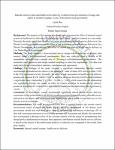| dc.description.abstract | Background: The purpose of this study was to empirically document the effect of internal control
system on health service delivery in Uganda using Lira District Local Government as a case study.
Precisely, the study established the effect of control environment on health service delivery in Lira
District Local Government, assessed the effect of risk assessment on health service delivery in Lira
District Government, and examined THE effect of control activities on health service delivery in
Lira District Local Government.
Methods: The study adopted a cross-sectional survey design which made use of primary data
sourced suing a self-administered questionnaire. Data was collected from a sample of 90
respondents extracted from a sample size of 130 using a self-administered questionnaire. The
researcher used purposive and simple random sampling to select the respondents. The data was
analysed in terms of descriptive statistics, correlations and regressions.
Findings: The findings of the study revealed a significant relationship between control
environment and health service delivery (an adjusted R2
value of about 20% with a p-value <0.05
at the 95% significance level). Secondly, the effect of risk assessment on health service delivery
produces an adjusted R2 OF ABOUT 20%. In addition, the result from the ANOVA table exhibited
a significant linear relationship [F (1, 88) = 10.654, p < 0.05] which meant that the relationship
was significant. Thirdly, the results on effect of control activities on health service delivery
produced an adjusted R2
of about 29% and further revealed that the relationship was significant (p
<0.05).
Conclusion: In conclusion, control environment significant affects health service delivery,
assessment of risk performed in Lira District Local Government enhanced quality of health service
delivered in the district and control activities significantly affect health service delivery in Lira
District Local Government.
Recommendations: The study recommended that there is need to improve the current control
environment aimed at improving health service delivery, management of lira district local
government should also start thinking in terms of incorporating information technology (IT) in
their risk assessment processes so as to enable accurate risk assessment and finally, the researcher
also recommends a through review of the existing controls with the aimed of strengthening then
though policy implementation because their apparent contribution towards health service delivery
is based on the results of the multivariate analysis is relatively low compared to the results from
prior studies.
Keywords: Internal control system, health service delivery | en_US |

